jump start Seat Altea 2013 Owner's Manual
[x] Cancel search | Manufacturer: SEAT, Model Year: 2013, Model line: Altea, Model: Seat Altea 2013Pages: 315, PDF Size: 4.66 MB
Page 6 of 315
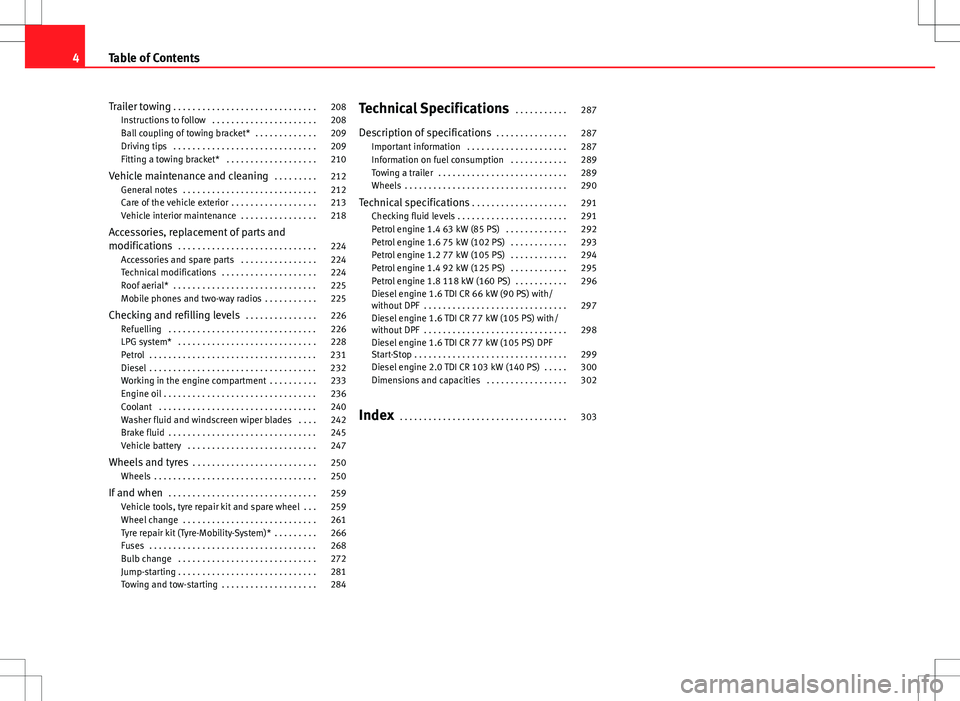
Trailer towing . . . . . . . . . . . . . . . . . . . . . . . . . . . . . . 208
Instructions to follow . . . . . . . . . . . . . . . . . . . . . . 208
Ball coupling of towing bracket* . . . . . . . . . . . . . 209
Driving tips . . . . . . . . . . . . . . . . . . . . . . . . . . . . . . 209
Fitting a towing bracket* . . . . . . . . . . . . . . . . . . . 210
Vehicle maintenance and cleaning . . . . . . . . . 212
General notes . . . . . . . . . . . . . . . . . . . . . . . . . . . . 212
Care of the vehicle exterior . . . . . . . . . . . . . . . . . . 213
Vehicle interior maintenance . . . . . . . . . . . . . . . . 218
Accessories, replacement of parts and
modifications . . . . . . . . . . . . . . . . . . . . . . . . . . . . . 224
Accessories and spare parts . . . . . . . . . . . . . . . . 224
Technical modifications . . . . . . . . . . . . . . . . . . . . 224
Roof aerial* . . . . . . . . . . . . . . . . . . . . . . . . . . . . . . 225
Mobile phones and two-way radios . . . . . . . . . . . 225
Checking and refilling levels . . . . . . . . . . . . . . . 226
Refuelling . . . . . . . . . . . . . . . . . . . . . . . . . . . . . . . 226
LPG system* . . . . . . . . . . . . . . . . . . . . . . . . . . . . . 228
Petrol . . . . . . . . . . . . . . . . . . . . . . . . . . . . . . . . . . . 231
Diesel . . . . . . . . . . . . . . . . . . . . . . . . . . . . . . . . . . . 232
Working in the engine compartment . . . . . . . . . . 233
Engine oil . . . . . . . . . . . . . . . . . . . . . . . . . . . . . . . . 236
Coolant . . . . . . . . . . . . . . . . . . . . . . . . . . . . . . . . . 240
Washer fluid and windscreen wiper blades . . . . 242
Brake fluid . . . . . . . . . . . . . . . . . . . . . . . . . . . . . . . 245
Vehicle battery . . . . . . . . . . . . . . . . . . . . . . . . . . . 247
Wheels and tyres . . . . . . . . . . . . . . . . . . . . . . . . . . 250
Wheels . . . . . . . . . . . . . . . . . . . . . . . . . . . . . . . . . . 250
If and when . . . . . . . . . . . . . . . . . . . . . . . . . . . . . . . 259
Vehicle tools, tyre repair kit and spare wheel . . . 259
Wheel change . . . . . . . . . . . . . . . . . . . . . . . . . . . . 261
Tyre repair kit (Tyre-Mobility-System)* . . . . . . . . . 266
Fuses . . . . . . . . . . . . . . . . . . . . . . . . . . . . . . . . . . . 268
Bulb change . . . . . . . . . . . . . . . . . . . . . . . . . . . . . 272
Jump-starting . . . . . . . . . . . . . . . . . . . . . . . . . . . . . 281
Towing and tow-starting . . . . . . . . . . . . . . . . . . . . 284 Technical Specifications
. . . . . . . . . . . 287
Description of specifications . . . . . . . . . . . . . . . 287
Important information . . . . . . . . . . . . . . . . . . . . . 287
Information on fuel consumption . . . . . . . . . . . . 289
Towing a trailer . . . . . . . . . . . . . . . . . . . . . . . . . . . 289
Wheels . . . . . . . . . . . . . . . . . . . . . . . . . . . . . . . . . . 290
Technical specifications . . . . . . . . . . . . . . . . . . . . 291
Checking fluid levels . . . . . . . . . . . . . . . . . . . . . . . 291
Petrol engine 1.4 63 kW (85 PS) . . . . . . . . . . . . . 292
Petrol engine 1.6 75 kW (102 PS) . . . . . . . . . . . . 293
Petrol engine 1.2 77 kW (105 PS) . . . . . . . . . . . . 294
Petrol engine 1.4 92 kW (125 PS) . . . . . . . . . . . . 295
Petrol engine 1.8 118 kW (160 PS) . . . . . . . . . . . 296
Diesel engine 1.6 TDI CR 66 kW (90 PS) with/
without DPF . . . . . . . . . . . . . . . . . . . . . . . . . . . . . . 297
Diesel engine 1.6 TDI CR 77 kW (105 PS) with/
without DPF . . . . . . . . . . . . . . . . . . . . . . . . . . . . . . 298
Diesel engine 1.6 TDI CR 77 kW (105 PS) DPF
Start-Stop . . . . . . . . . . . . . . . . . . . . . . . . . . . . . . . . 299
Diesel engine 2.0 TDI CR 103 kW (140 PS) . . . . . 300
Dimensions and capacities . . . . . . . . . . . . . . . . . 302
Index . . . . . . . . . . . . . . . . . . . . . . . . . . . . . . . . . . . 303
4Table of Contents
Page 175 of 315
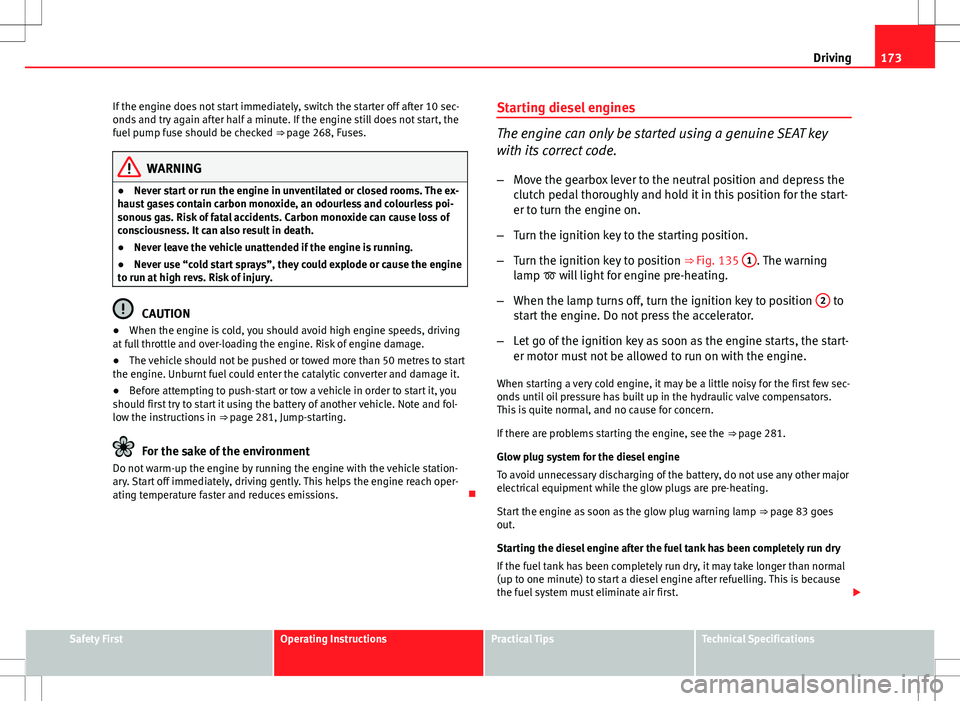
173
Driving
If the engine does not start immediately, switch the starter off after 10 sec-
onds and try again after half a minute. If the engine still does not start, the
fuel pump fuse should be checked ⇒ page 268, Fuses.
WARNING
● Never start or run the engine in unventilated or closed rooms. The ex-
haust gases contain carbon monoxide, an odourless and colourless poi-
sonous gas. Risk of fatal accidents. Carbon monoxide can cause loss of
consciousness. It can also result in death.
● Never leave the vehicle unattended if the engine is running.
● Never use “cold start sprays”, they could explode or cause the engine
to run at high revs. Risk of injury.
CAUTION
● When the engine is cold, you should avoid high engine speeds, driving
at full throttle and over-loading the engine. Risk of engine damage.
● The vehicle should not be pushed or towed more than 50 metres to start
the engine. Unburnt fuel could enter the catalytic converter and damage it.
● Before attempting to push-start or tow a vehicle in order to start it, you
should first try to start it using the battery of another vehicle. Note and fol-
low the instructions in ⇒ page 281, Jump-starting.
For the sake of the environment
Do not warm-up the engine by running the engine with the vehicle station-
ary. Start off immediately, driving gently. This helps the engine reach oper-
ating temperature faster and reduces emissions. Starting diesel engines
The engine can only be started using a genuine SEAT key
with its correct code.
– Move the gearbox lever to the neutral position and depress the
clutch pedal thoroughly and hold it in this position for the start-
er to turn the engine on.
– Turn the ignition key to the starting position.
– Turn the ignition key to position ⇒ Fig. 135 1
. The warning
lamp will light for engine pre-heating.
– When the lamp turns off, turn the ignition key to position 2
to
start the engine. Do not press the accelerator.
– Let go of the ignition key as soon as the engine starts, the start-
er motor must not be allowed to run on with the engine.
When starting a very cold engine, it may be a little noisy for the first few sec-
onds until oil pressure has built up in the hydraulic valve compensators.
This is quite normal, and no cause for concern.
If there are problems starting the engine, see the ⇒ page 281.
Glow plug system for the diesel engine
To avoid unnecessary discharging of the battery, do not use any other major
electrical equipment while the glow plugs are pre-heating.
Start the engine as soon as the glow plug warning lamp ⇒ page 83 goes
out.
Starting the diesel engine after the fuel tank has been completely run dry
If the fuel tank has been completely run dry, it may take longer than normal
(up to one minute) to start a diesel engine after refuelling. This is because
the fuel system must eliminate air first.
Safety FirstOperating InstructionsPractical TipsTechnical Specifications
Page 176 of 315
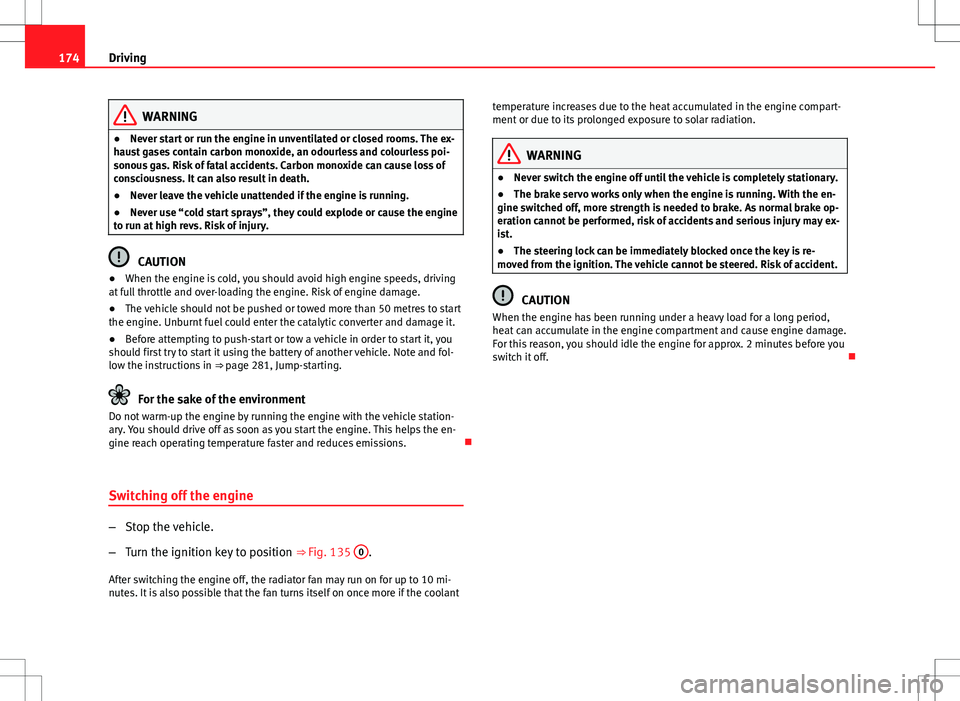
174Driving
WARNING
● Never start or run the engine in unventilated or closed rooms. The ex-
haust gases contain carbon monoxide, an odourless and colourless poi-
sonous gas. Risk of fatal accidents. Carbon monoxide can cause loss of
consciousness. It can also result in death.
● Never leave the vehicle unattended if the engine is running.
● Never use “cold start sprays”, they could explode or cause the engine
to run at high revs. Risk of injury.
CAUTION
● When the engine is cold, you should avoid high engine speeds, driving
at full throttle and over-loading the engine. Risk of engine damage.
● The vehicle should not be pushed or towed more than 50 metres to start
the engine. Unburnt fuel could enter the catalytic converter and damage it.
● Before attempting to push-start or tow a vehicle in order to start it, you
should first try to start it using the battery of another vehicle. Note and fol-
low the instructions in ⇒ page 281, Jump-starting.
For the sake of the environment
Do not warm-up the engine by running the engine with the vehicle station-
ary. You should drive off as soon as you start the engine. This helps the en-
gine reach operating temperature faster and reduces emissions.
Switching off the engine
– Stop the vehicle.
– Turn the ignition key to position ⇒ Fig. 135 0
.
After switching the engine off, the radiator fan may run on for up to 10 mi-
nutes. It is also possible that the fan turns itself on once more if the coolant temperature increases due to the heat accumulated in the engine compart-
ment or due to its prolonged exposure to solar radiation.
WARNING
● Never switch the engine off until the vehicle is completely stationary.
● The brake servo works only when the engine is running. With the en-
gine switched off, more strength is needed to brake. As normal brake op-
eration cannot be performed, risk of accidents and serious injury may ex-
ist.
● The steering lock can be immediately blocked once the key is re-
moved from the ignition. The vehicle cannot be steered. Risk of accident.
CAUTION
When the engine has been running under a heavy load for a long period,
heat can accumulate in the engine compartment and cause engine damage.
For this reason, you should idle the engine for approx. 2 minutes before you
switch it off.
Page 205 of 315
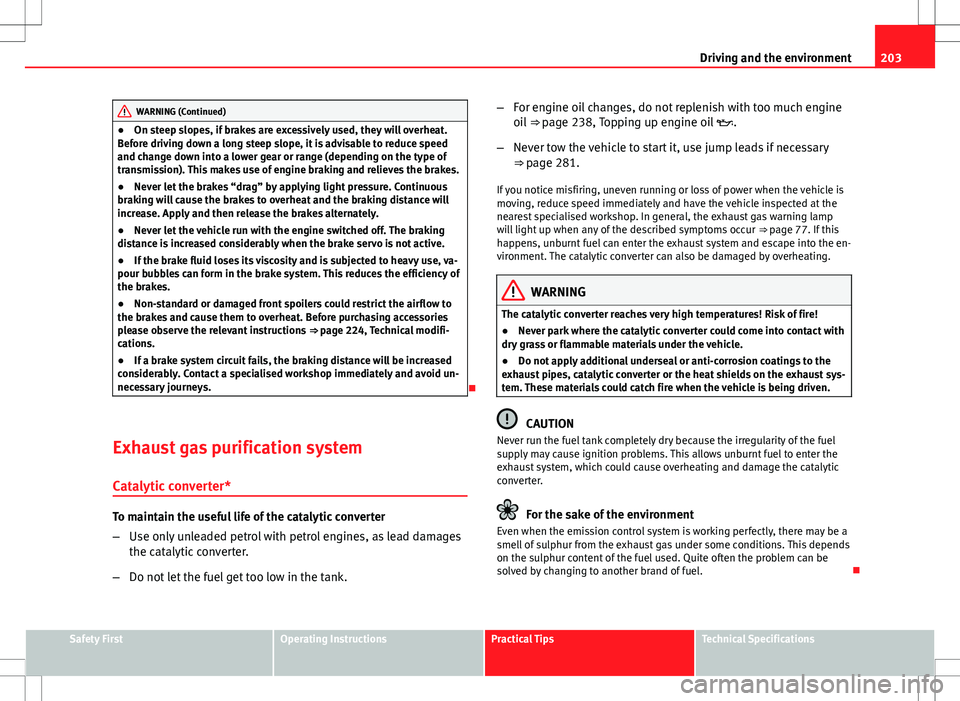
203
Driving and the environment
WARNING (Continued)
● On steep slopes, if brakes are excessively used, they will overheat.
Before driving down a long steep slope, it is advisable to reduce speed
and change down into a lower gear or range (depending on the type of
transmission). This makes use of engine braking and relieves the brakes.
● Never let the brakes “drag” by applying light pressure. Continuous
braking will cause the brakes to overheat and the braking distance will
increase. Apply and then release the brakes alternately.
● Never let the vehicle run with the engine switched off. The braking
distance is increased considerably when the brake servo is not active.
● If the brake fluid loses its viscosity and is subjected to heavy use, va-
pour bubbles can form in the brake system. This reduces the efficiency of
the brakes.
● Non-standard or damaged front spoilers could restrict the airflow to
the brakes and cause them to overheat. Before purchasing accessories
please observe the relevant instructions ⇒ page 224, Technical modifi-
cations.
● If a brake system circuit fails, the braking distance will be increased
considerably. Contact a specialised workshop immediately and avoid un-
necessary journeys.
Exhaust gas purification system Catalytic converter*
To maintain the useful life of the catalytic converter
– Use only unleaded petrol with petrol engines, as lead damages
the catalytic converter.
– Do not let the fuel get too low in the tank. –
For engine oil changes, do not replenish with too much engine
oil ⇒ page 238, Topping up engine oil .
– Never tow the vehicle to start it, use jump leads if necessary
⇒ page 281.
If you notice misfiring, uneven running or loss of power when the vehicle is
moving, reduce speed immediately and have the vehicle inspected at the
nearest specialised workshop. In general, the exhaust gas warning lamp
will light up when any of the described symptoms occur ⇒ page 77. If this
happens, unburnt fuel can enter the exhaust system and escape into the en-
vironment. The catalytic converter can also be damaged by overheating.
WARNING
The catalytic converter reaches very high temperatures! Risk of fire!
● Never park where the catalytic converter could come into contact with
dry grass or flammable materials under the vehicle.
● Do not apply additional underseal or anti-corrosion coatings to the
exhaust pipes, catalytic converter or the heat shields on the exhaust sys-
tem. These materials could catch fire when the vehicle is being driven.
CAUTION
Never run the fuel tank completely dry because the irregularity of the fuel
supply may cause ignition problems. This allows unburnt fuel to enter the
exhaust system, which could cause overheating and damage the catalytic
converter.
For the sake of the environment
Even when the emission control system is working perfectly, there may be a
smell of sulphur from the exhaust gas under some conditions. This depends
on the sulphur content of the fuel used. Quite often the problem can be
solved by changing to another brand of fuel.
Safety FirstOperating InstructionsPractical TipsTechnical Specifications
Page 235 of 315
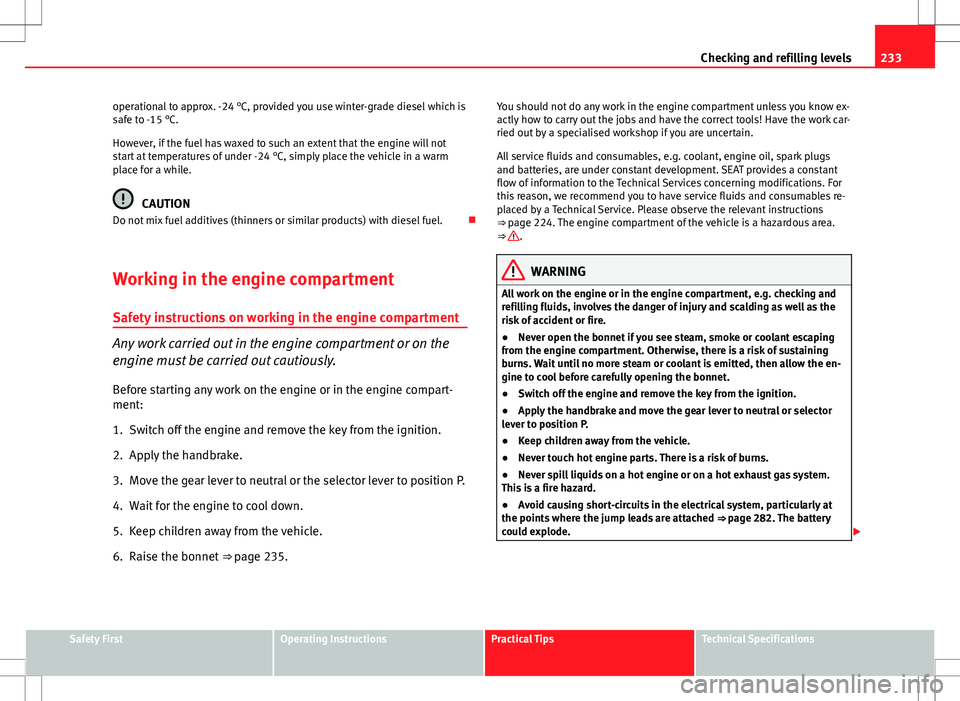
233
Checking and refilling levels
operational to approx. -24 °C, provided you use winter-grade diesel which is
safe to -15 °C.
However, if the fuel has waxed to such an extent that the engine will not
start at temperatures of under -24 °C, simply place the vehicle in a warm
place for a while.
CAUTION
Do not mix fuel additives (thinners or similar products) with diesel fuel.
Working in the engine compartment Safety instructions on working in the engine compartment
Any work carried out in the engine compartment or on the
engine must be carried out cautiously.
Before starting any work on the engine or in the engine compart-
ment:
1. Switch off the engine and remove the key from the ignition.
2. Apply the handbrake.
3. Move the gear lever to neutral or the selector lever to position P.
4. Wait for the engine to cool down.
5. Keep children away from the vehicle.
6. Raise the bonnet ⇒ page 235. You should not do any work in the engine compartment unless you know ex-
actly how to carry out the jobs and have the correct tools! Have the work car-
ried out by a specialised workshop if you are uncertain.
All service fluids and consumables, e.g. coolant, engine oil, spark plugs
and batteries, are under constant development. SEAT provides a constant
flow of information to the Technical Services concerning modifications. For
this reason, we recommend you to have service fluids and consumables re-
placed by a Technical Service. Please observe the relevant instructions
⇒ page 224. The engine compartment of the vehicle is a hazardous area.
⇒
.
WARNING
All work on the engine or in the engine compartment, e.g. checking and
refilling fluids, involves the danger of injury and scalding as well as the
risk of accident or fire.
● Never open the bonnet if you see steam, smoke or coolant escaping
from the engine compartment. Otherwise, there is a risk of sustaining
burns. Wait until no more steam or coolant is emitted, then allow the en-
gine to cool before carefully opening the bonnet.
● Switch off the engine and remove the key from the ignition.
● Apply the handbrake and move the gear lever to neutral or selector
lever to position P.
● Keep children away from the vehicle.
● Never touch hot engine parts. There is a risk of burns.
● Never spill liquids on a hot engine or on a hot exhaust gas system.
This is a fire hazard.
● Avoid causing short-circuits in the electrical system, particularly at
the points where the jump leads are attached ⇒ page 282. The battery
could explode.
Safety FirstOperating InstructionsPractical TipsTechnical Specifications
Page 283 of 315
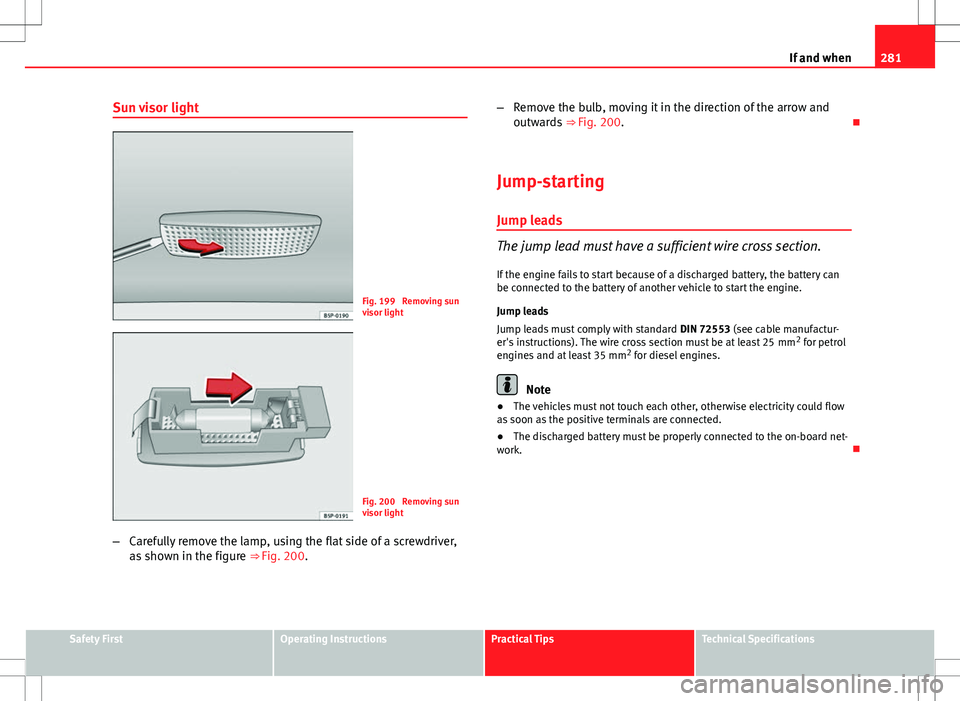
281
If and when
Sun visor light
Fig. 199 Removing sun
visor light
Fig. 200 Removing sun
visor light
– Carefully remove the lamp, using the flat side of a screwdriver,
as shown in the figure ⇒ Fig. 200. –
Remove the bulb, moving it in the direction of the arrow and
outwards ⇒ Fig. 200.
Jump-starting
Jump leads
The jump lead must have a sufficient wire cross section. If the engine fails to start because of a discharged battery, the battery can
be connected to the battery of another vehicle to start the engine.
Jump leads
Jump leads must comply with standard DIN 72553 (see cable manufactur-
er's instructions). The wire cross section must be at least 25 mm 2
for petrol
engines and at least 35 mm 2
for diesel engines.
Note
● The vehicles must not touch each other, otherwise electricity could flow
as soon as the positive terminals are connected.
● The discharged battery must be properly connected to the on-board net-
work.
Safety FirstOperating InstructionsPractical TipsTechnical Specifications
Page 284 of 315
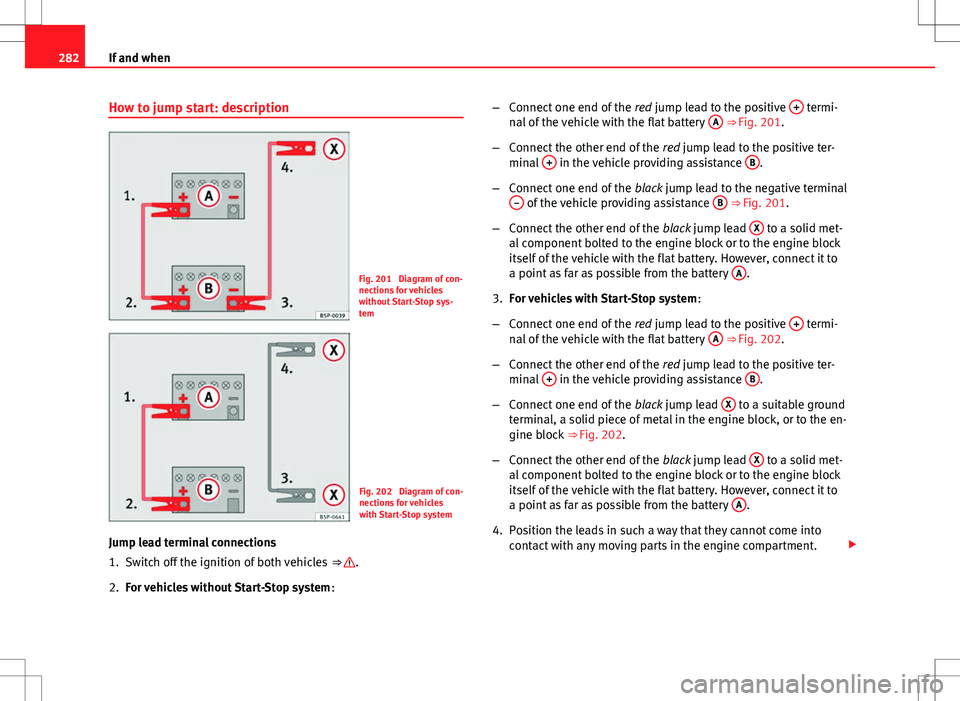
282If and when
How to jump start: description
Fig. 201 Diagram of con-
nections for vehicles
without Start-Stop sys-
tem
Fig. 202 Diagram of con-
nections for vehicles
with Start-Stop system
Jump lead terminal connections
1. Switch off the ignition of both vehicles ⇒
.
2. For vehicles without Start-Stop system :–
Connect one end of the red jump lead to the positive +
termi-
nal of the vehicle with the flat battery A ⇒ Fig. 201.
– Connect the other end of the red jump lead to the positive ter-
minal +
in the vehicle providing assistance B.
– Connect one end of the black jump lead to the negative terminal
–
of the vehicle providing assistance B ⇒ Fig. 201.
– Connect the other end of the black jump lead X
to a solid met-
al component bolted to the engine block or to the engine block
itself of the vehicle with the flat battery. However, connect it to
a point as far as possible from the battery A
.
3. For vehicles with Start-Stop system :
– Connect one end of the red jump lead to the positive +
termi-
nal of the vehicle with the flat battery A ⇒ Fig. 202.
– Connect the other end of the red jump lead to the positive ter-
minal +
in the vehicle providing assistance B.
– Connect one end of the black jump lead X
to a suitable ground
terminal, a solid piece of metal in the engine block, or to the en-
gine block ⇒ Fig. 202.
– Connect the other end of the black jump lead X
to a solid met-
al component bolted to the engine block or to the engine block
itself of the vehicle with the flat battery. However, connect it to
a point as far as possible from the battery A
.
4. Position the leads in such a way that they cannot come into contact with any moving parts in the engine compartment.
Page 285 of 315
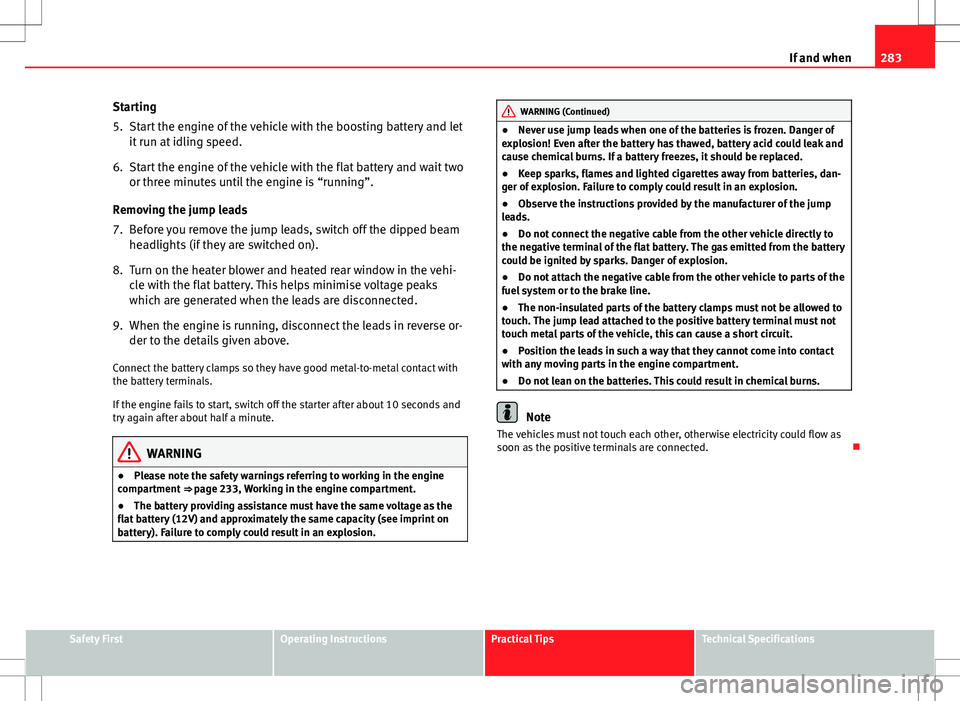
283
If and when
Starting
5. Start the engine of the vehicle with the boosting battery and let it run at idling speed.
6. Start the engine of the vehicle with the flat battery and wait two or three minutes until the engine is “running”.
Removing the jump leads
7. Before you remove the jump leads, switch off the dipped beam headlights (if they are switched on).
8. Turn on the heater blower and heated rear window in the vehi- cle with the flat battery. This helps minimise voltage peaks
which are generated when the leads are disconnected.
9. When the engine is running, disconnect the leads in reverse or- der to the details given above.
Connect the battery clamps so they have good metal-to-metal contact with
the battery terminals.
If the engine fails to start, switch off the starter after about 10 seconds and
try again after about half a minute.
WARNING
● Please note the safety warnings referring to working in the engine
compartment ⇒ page 233, Working in the engine compartment.
● The battery providing assistance must have the same voltage as the
flat battery (12V) and approximately the same capacity (see imprint on
battery). Failure to comply could result in an explosion.
WARNING (Continued)
● Never use jump leads when one of the batteries is frozen. Danger of
explosion! Even after the battery has thawed, battery acid could leak and
cause chemical burns. If a battery freezes, it should be replaced.
● Keep sparks, flames and lighted cigarettes away from batteries, dan-
ger of explosion. Failure to comply could result in an explosion.
● Observe the instructions provided by the manufacturer of the jump
leads.
● Do not connect the negative cable from the other vehicle directly to
the negative terminal of the flat battery. The gas emitted from the battery
could be ignited by sparks. Danger of explosion.
● Do not attach the negative cable from the other vehicle to parts of the
fuel system or to the brake line.
● The non-insulated parts of the battery clamps must not be allowed to
touch. The jump lead attached to the positive battery terminal must not
touch metal parts of the vehicle, this can cause a short circuit.
● Position the leads in such a way that they cannot come into contact
with any moving parts in the engine compartment.
● Do not lean on the batteries. This could result in chemical burns.
Note
The vehicles must not touch each other, otherwise electricity could flow as
soon as the positive terminals are connected.
Safety FirstOperating InstructionsPractical TipsTechnical Specifications
Page 286 of 315
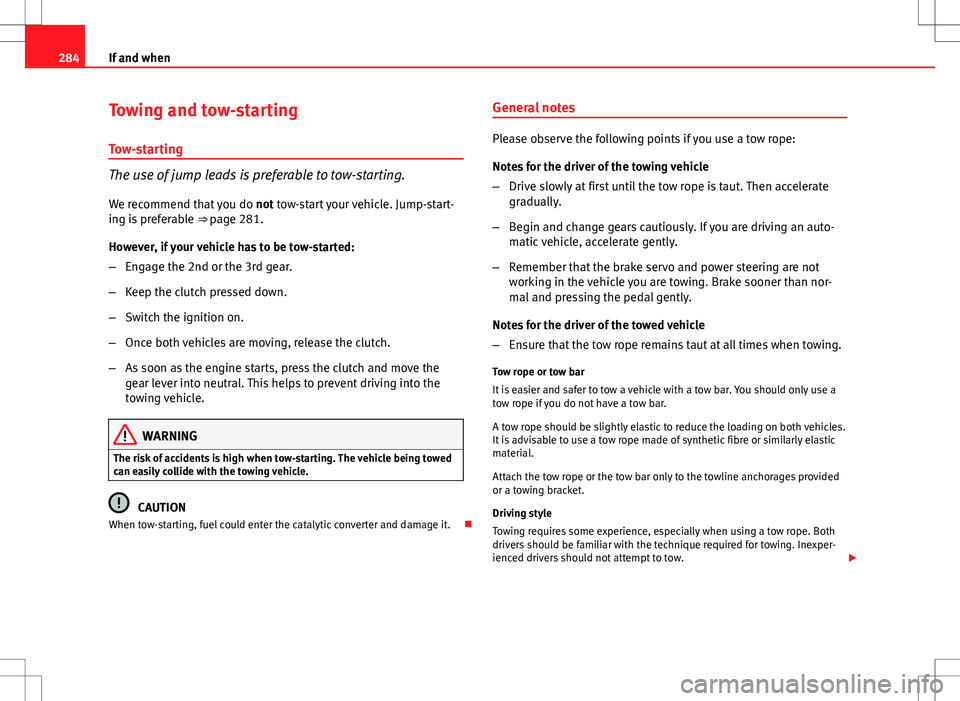
284If and when
Towing and tow-starting
Tow-starting
The use of jump leads is preferable to tow-starting.
We recommend that you do not tow-start your vehicle. Jump-start-
ing is preferable ⇒ page 281.
However, if your vehicle has to be tow-started:
– Engage the 2nd or the 3rd gear.
– Keep the clutch pressed down.
– Switch the ignition on.
– Once both vehicles are moving, release the clutch.
– As soon as the engine starts, press the clutch and move the
gear lever into neutral. This helps to prevent driving into the
towing vehicle.
WARNING
The risk of accidents is high when tow-starting. The vehicle being towed
can easily collide with the towing vehicle.
CAUTION
When tow-starting, fuel could enter the catalytic converter and damage it. General notes
Please observe the following points if you use a tow rope:
Notes for the driver of the towing vehicle
–
Drive slowly at first until the tow rope is taut. Then accelerate
gradually.
– Begin and change gears cautiously. If you are driving an auto-
matic vehicle, accelerate gently.
– Remember that the brake servo and power steering are not
working in the vehicle you are towing. Brake sooner than nor-
mal and pressing the pedal gently.
Notes for the driver of the towed vehicle
– Ensure that the tow rope remains taut at all times when towing.
Tow rope or tow bar
It is easier and safer to tow a vehicle with a tow bar. You should only use a
tow rope if you do not have a tow bar.
A tow rope should be slightly elastic to reduce the loading on both vehicles.
It is advisable to use a tow rope made of synthetic fibre or similarly elastic
material.
Attach the tow rope or the tow bar only to the towline anchorages provided
or a towing bracket.
Driving style
Towing requires some experience, especially when using a tow rope. Both
drivers should be familiar with the technique required for towing. Inexper-
ienced drivers should not attempt to tow.
Page 309 of 315
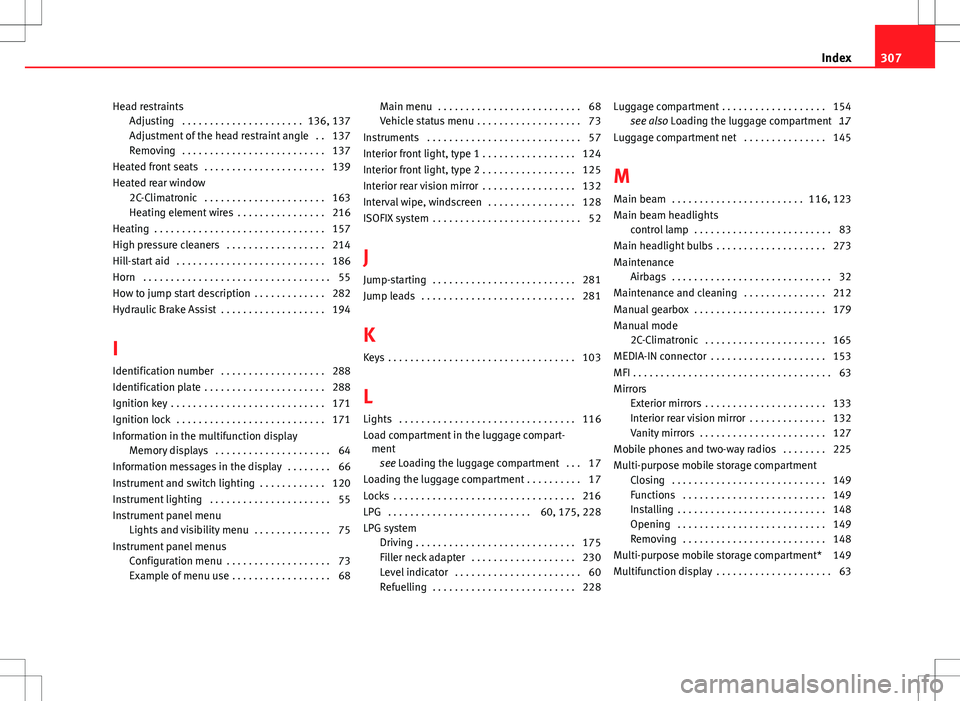
Head restraintsAdjusting . . . . . . . . . . . . . . . . . . . . . . 136, 137
Adjustment of the head restraint angle . . 137
Removing . . . . . . . . . . . . . . . . . . . . . . . . . . 137
Heated front seats . . . . . . . . . . . . . . . . . . . . . . 139
Heated rear window 2C-Climatronic . . . . . . . . . . . . . . . . . . . . . . 163
Heating element wires . . . . . . . . . . . . . . . . 216
Heating . . . . . . . . . . . . . . . . . . . . . . . . . . . . . . . 157
High pressure cleaners . . . . . . . . . . . . . . . . . . 214
Hill-start aid . . . . . . . . . . . . . . . . . . . . . . . . . . . 186
Horn . . . . . . . . . . . . . . . . . . . . . . . . . . . . . . . . . . 55
How to jump start description . . . . . . . . . . . . . 282
Hydraulic Brake Assist . . . . . . . . . . . . . . . . . . . 194
I
Identification number . . . . . . . . . . . . . . . . . . . 288
Identification plate . . . . . . . . . . . . . . . . . . . . . . 288
Ignition key . . . . . . . . . . . . . . . . . . . . . . . . . . . . 171
Ignition lock . . . . . . . . . . . . . . . . . . . . . . . . . . . 171
Information in the multifunction display Memory displays . . . . . . . . . . . . . . . . . . . . . 64
Information messages in the display . . . . . . . . 66
Instrument and switch lighting . . . . . . . . . . . . 120
Instrument lighting . . . . . . . . . . . . . . . . . . . . . . 55
Instrument panel menu Lights and visibility menu . . . . . . . . . . . . . . 75
Instrument panel menus Configuration menu . . . . . . . . . . . . . . . . . . . 73
Example of menu use . . . . . . . . . . . . . . . . . . 68 Main menu . . . . . . . . . . . . . . . . . . . . . . . . . . 68
Vehicle status menu . . . . . . . . . . . . . . . . . . . 73
Instruments . . . . . . . . . . . . . . . . . . . . . . . . . . . . 57
Interior front light, type 1 . . . . . . . . . . . . . . . . . 124
Interior front light, type 2 . . . . . . . . . . . . . . . . . 125
Interior rear vision mirror . . . . . . . . . . . . . . . . . 132
Interval wipe, windscreen . . . . . . . . . . . . . . . . 128
ISOFIX system . . . . . . . . . . . . . . . . . . . . . . . . . . . 52
J
Jump-starting . . . . . . . . . . . . . . . . . . . . . . . . . . 281
Jump leads . . . . . . . . . . . . . . . . . . . . . . . . . . . . 281
K
Keys . . . . . . . . . . . . . . . . . . . . . . . . . . . . . . . . . . 103
L
Lights . . . . . . . . . . . . . . . . . . . . . . . . . . . . . . . . 116
Load compartment in the luggage compart- ment
see Loading the luggage compartment . . . 17
Loading the luggage compartment . . . . . . . . . . 17
Locks . . . . . . . . . . . . . . . . . . . . . . . . . . . . . . . . . 216
LPG . . . . . . . . . . . . . . . . . . . . . . . . . . 60, 175, 228
LPG system Driving . . . . . . . . . . . . . . . . . . . . . . . . . . . . . 175
Filler neck adapter . . . . . . . . . . . . . . . . . . . 230
Level indicator . . . . . . . . . . . . . . . . . . . . . . . 60
Refuelling . . . . . . . . . . . . . . . . . . . . . . . . . . 228 Luggage compartment . . . . . . . . . . . . . . . . . . . 154
see also Loading the luggage compartment . .17
Luggage compartment net . . . . . . . . . . . . . . . 145
M
Main beam . . . . . . . . . . . . . . . . . . . . . . . . 116, 123
Main beam headlights control lamp . . . . . . . . . . . . . . . . . . . . . . . . . 83
Main headlight bulbs . . . . . . . . . . . . . . . . . . . . 273
Maintenance Airbags . . . . . . . . . . . . . . . . . . . . . . . . . . . . . 32
Maintenance and cleaning . . . . . . . . . . . . . . . 212
Manual gearbox . . . . . . . . . . . . . . . . . . . . . . . . 179
Manual mode 2C-Climatronic . . . . . . . . . . . . . . . . . . . . . . 165
MEDIA-IN connector . . . . . . . . . . . . . . . . . . . . . 153
MFI . . . . . . . . . . . . . . . . . . . . . . . . . . . . . . . . . . . . 63
Mirrors Exterior mirrors . . . . . . . . . . . . . . . . . . . . . . 133
Interior rear vision mirror . . . . . . . . . . . . . . 132
Vanity mirrors . . . . . . . . . . . . . . . . . . . . . . . 127
Mobile phones and two-way radios . . . . . . . . 225
Multi-purpose mobile storage compartment Closing . . . . . . . . . . . . . . . . . . . . . . . . . . . . 149
Functions . . . . . . . . . . . . . . . . . . . . . . . . . . 149
Installing . . . . . . . . . . . . . . . . . . . . . . . . . . . 148
Opening . . . . . . . . . . . . . . . . . . . . . . . . . . . 149
Removing . . . . . . . . . . . . . . . . . . . . . . . . . . 148
Multi-purpose mobile storage compartment* 149
Multifunction display . . . . . . . . . . . . . . . . . . . . . 63
307
Index